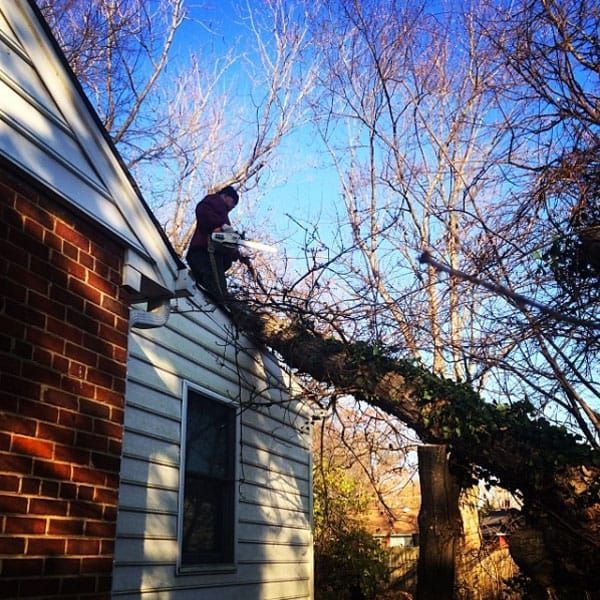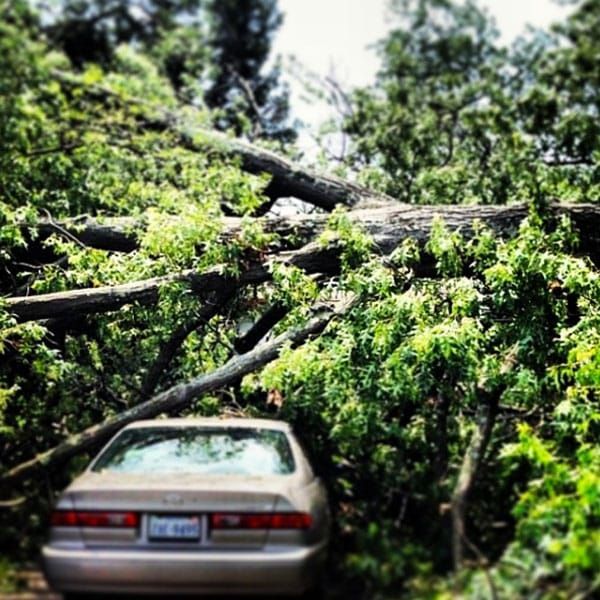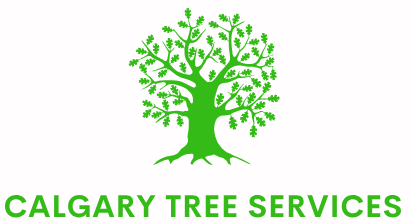Calgary Tree Services
Emergency Tree Removal
Every year, a significant number of trees fall on houses, automobiles, buildings, structures, power lines, and more. At Calgary Tree Services, we’re highly specialized for this very type of emergency tree removal service. Every year, we receive many urgent calls from homeowners throughout Kelowna asking us to remove trees that fall during these dangerous conditions.
If you need help with any of the following, just give us a call.
We can generally respond to your emergency within an hour or two.
- Large and hazardous tree take downs
- Storm damage clean-up
- Assessment and removal of trees with property damage
- Evaluation and handling of dangerous trees
In emergency situations, and especially after a storm, the surrounding area where trees have fallen is extremely unsafe. Trees and branches may be under extreme pressure - if they break, they can cause severe injury or death. Other trees or limbs may be hanging and ready to fall.
If you feel a tree is about to fall on your home vacate the premises ASAP. Give us a call and our staff will safely maneuver around the tree and solve this problem in the safest and most efficient way possible.
If a tree has fallen on your home, vacate the premises and call us immediately! Fallen trees can result in dangerous electrical sparks or gas leaks and cause extensive damage inside the home.

Get Instant Quote
Contact Us

Calgary Tree Services Emergency Tree Removals
Trees often bring down power lines, causing dangerous conditions for homeowners and tree care workers to perform emergency tree work, the appropriate skills are critical. Tree care, especially during emergency situations, is the 2nd most dangerous industry in the world. Lives are lost, and major injuries occur every day in the tree service business. That’s why hiring a licensed, bonded, and insured professional tree service is an absolute necessity. Calgary Tree Service has the skills and manpower to complete these emergency tree removals in a safe, timely, and efficient manner. When large storms sweep through and cause major tree damage by way of wind, rain, ice, or snow. During these times, you will need a Tree Service company to handle these emergency jobs.
Storm Damage Prevention
While there may be nothing you can do to completely avoid tree damage from heavy snow and ice, hurricanes or flooding, it IS possible to minimize the risk. Careful inspection can reveal defects in your trees that make them more prone to breakage, falling over, or splitting unexpectedly. The best way to minimize the risk of storm damage caused by trees, and protect yourself and your property, is to perform a regular tree inspection. Take some time to examine your trees (from the ground – don’t try to climb them!). See if you spot any of the following issues, all of which increase the risk of damage from storms.
Potential Risk Factors
Dead or damaged branches and/or trees.
Look for deadwood, cracks or splits, hanging branches or any other sort of damage. These are more likely to snap when under pressure from high winds.
Diseased or decayed wood.
Trees and branches that aren’t healthy are generally weaker and more vulnerable to breakage.
Structural problems.
While a tree care professional is best able to identify structural problems that compromise the stability of a tree, there are some things you can see yourself. Look for V-shaped crotches, crossing branches that are rubbing against each other, and top-heavy trees (where the canopy has been excessively “lifted” to provide more clearance underneath).
Severely leaning trees.
Just because a tree is leaning doesn’t mean that it will fall over. But the more it leans, the greater the risk of failure, especially when rains have saturated the ground.
Poor root structure.
A tree that’s not firmly anchored is more susceptible to failure during a storm. Things to look out for include girdling roots, cut or damaged roots (such as from nearby construction) and newly planted trees with little root growth.
Topped trees.
We do not top trees because new growth is poorly attached and susceptible to breakage (among other problems). If a tree has previously been topped, it should be inspected for potential safety issues.
Lion-tailed trees.
This is another pruning method we don’t employ because of health and safety implications for the tree. During a storm, the heavy foliage growth at the end of long, bare branch gets whipped around, breaking the branches.
Overly dense canopy.
A tree with a thick canopy of leaves acts as a sail, rather than letting the wind pass through.
Improperly pruned trees.
Some trees are mistakenly “thinned” by removing a lot of branches from the interior of the tree, while leaving plenty of foliage around the outside. Unfortunately, this misguided technique makes storm damage more likely.
If you notice anything that concerns you, give us a call. Our tree care professionals are trained to look for potential hazards posed by your trees. We’ll be able to address these risks and take proper action – such as remove dead trees, pruning, cabling or using fertilization to improve the health of your trees – before any major storms come through.
What to Expect
During business hours, there's always someone to answer the phone. However, extreme weather can causes extensive tree damage throughout the area, and leave us swamped with phone calls so we may ask you to leave a message. Our arborists will assess the situation with your tree or trees and determine the best way to fix the problem. They'll provide a detailed quote for the work.
Depending on the situation, trucks and heavy equipment may need to access your property. If there are other trees down in the area and blocking roads, there may be a delay in reaching your property. We take great care to have as little impact on the surrounding area as possible while safely addressing your tree emergency. Experienced safety professionals will be on site to ensure staff follow the highest safety standards.
Safety advice
When trees or branches are damaged or have fallen, it places enormous stress on the rest of the tree. When the tree or branch is moved or cut, the remaining wood can react violently and unexpectedly to the change in forces acting on it. Fallen trees can roll (crushing anyone standing nearby), branches can spring back or sideways (hitting anything nearby), and additional pieces can drop (hitting whatever is below).
Dealing with damaged trees is not a DIY job.
It requires specialized equipment, including safety equipment, and extensive skills and training to do it efficiently, properly and safely. Many homeowners have been killed trying to remove a storm-damaged tree. Please don't let that happen to you. Leave it to the tree service pros!
A tree or limb has fallen on my property. What should I do?
Call us for 24-hour emergency tree service. We recommend staying away from the tree to prevent injuries and additional damage. Don’t try to remove storm-damaged trees yourself.
How soon should I call you after the storm damage has occurred?
Contact us as soon as possible. Make sure everyone is safe and keep people and pets away from the damaged or downed tree. Some storm-damaged trees can be unstable so should be dealt with quickly and by a professional that has the equipment, skills, and experience necessary.
Does homeowner’s insurance cover emergency tree removal?
It depends on your policy. Consult your homeowner’s insurance policies. Some will be covered if your trees are taken down or damaged by hail, high winds, ice, or other weather events. Other times it will only cover claims if the entire tree falls or does damage.
Read your policy carefully and check for any tree-related clauses.
Should I try to move any of the branches or debris before your crew arrives?
No, do not try to move or remove anything yourself. Storm-damaged trees can be very unstable and dangerous. It’s better to wait; we have the equipment, experience, and skills to deal with these types of situations.
What should I look for to determine the extent of the damage?
Dangerous situations abound with storm-damaged trees, so please keep a safe distance when surveying the damage.
Sometimes a fallen or broken tree may not seem dangerous, but there are certain things that make the situation more precarious, including:
Broken branches (some may be hidden from view)
Branches that have broken off but are wedged in the tree
Any level of tree decay that can make the tree unstable
Loose ground or heaving soil around the tree roots
Slight lean to the tree
Cracks or breaks in the tree
If you notice any of these signs on your tree after a storm, contact us as soon as possible.
My tree (or branches) broke and fell from the weight of ice. What should I do?
What to do with a fallen or severely damaged tree depends on the situation. Here are some general guidelines:
If the tree or sections of the tree are blocking a roadway, call your local municipal services.
If the tree is touching or has brought down utility lines, call your utility company. Never go near a tree that is touching power lines!
If your tree or large branches have fallen on your driveway (so you can’t get out) or on a building, call us for emergency tree removal.
If sections of a tree have fallen in your yard, or if there are broken branches that don’t appear to be in danger of falling or causing any further damage, schedule a professional tree consultation.
Do NOT try to cut or remove ice-covered branches yourself, especially with a chainsaw. It’s easy to be injured by a chainsaw slipping on the ice or a branch under load reacting forcefully and unexpectedly when cut.
